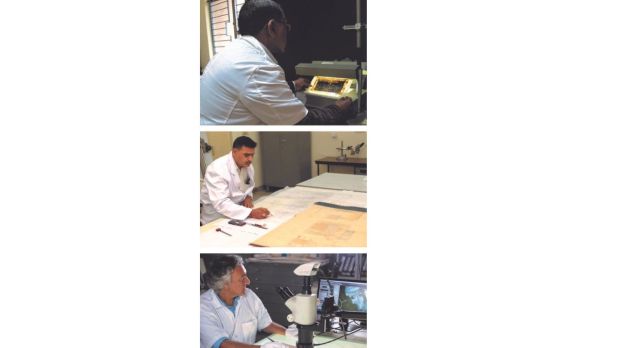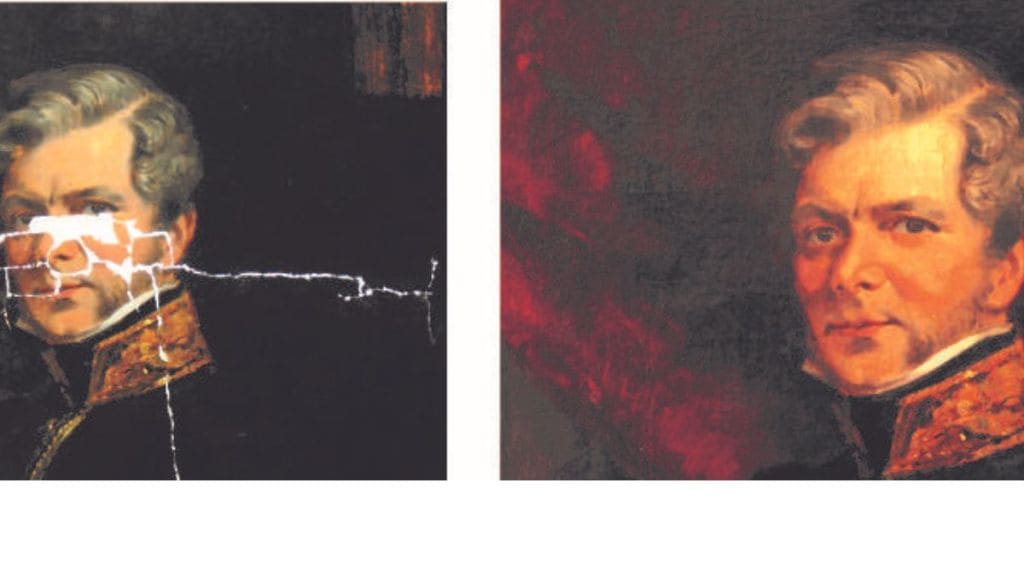By Raju Mansukhani
It began sometime in the 1970s-80s when Gael de Guichen, now a leading figure in the domain of preventive conservation and museum collection storage, began working with the ICCROM – International Centre for the Study of the Preservation and Restoration of Cultural Property in Rome. He contributed to developing the concept of preventive conservation in museums.
‘Conservation of Tangible Cultural Heritage – An Introductory Handbook’, released during the International Museum Expo in New Delhi from May 18-20, 2023, pays its homage to the pioneering spirit of de Guichen and the visionary works undertaken by ICCROM across the world.
Also Read: Traumas of partition and politics of subterfuge through 1947
Authored by Anupam Sah, head of art conservation, research, and training at CSMVS Museum, Mumbai, the handbook is a ready reckoner on conservation. Said Sah, in the preface, “conservation is a multidisciplinary profession now, no longer just the sciences, technology, humanities, fine arts, craftsmanship, manual and technical skills – heritage art conservation is complex. It is an effective lever for holistic development for institutions and society as a whole.” Through the handbook, Sah has shared his knowledge and expertise gathered when he was Director Projects (Conservation) at Indian National Trust for Art and Cultural Heritage.
“Given the various historic, artistic and sacred objects of the Indian subcontinent, we must know the principles of preventive conservation that protect cultural heritage from deteriorating in the first place,” he emphasised. Sah, a prodigious educator who teaches conservation at the University of Mumbai, with the backing of supporting institutions, helping develop facilities across India aimed at strengthening art conservation education and practice. These are long-term goals that may be realised over generations.
Gael de Guichen developed his seven-step approach to Preventive Conservation which the handbook provides for the reader. It is an easy-to-follow and friendly approach that advises museum professionals to: Know your collection; Identify the factors of deterioration or risk; Avoid the risks; Monitor the risks; Block the risks; Take Action; and Communicate the best practices and protocols developed.
Mugdha Sinha, Joint Secretary, Ministry of Culture said, “The handbook will serve as a checklist for developing captive conservation labs in the museums where tangible cultural heritage is preserved.” While most of the relics have found homes in museums, the majority are still left to fend for themselves. This is where the challenge of cultural preservation lies, she said.
Tangible cultural heritage refers to physical objects. These objects having been created centuries ago, preserved, and passed down through generations now need to get the benefit of modern science and technology. It comprises innovative creations, constructed heritage be it buildings, monuments, and other physical results of human ingenuity. As we look around ourselves our cities and villages are filled with ancient places of worship, forts, palaces, havelis and public spaces.
Museums, she emphasized, will need to set up conservation labs on their own premises to ensure preventive correction and care. The joint secretary has been the moving spirit behind the recently-concluded Museum Expo which received accolades from academicians, museologists, conservators, archive experts, students and professionals alike.

Said Usha Rani Tiwari, Professor in Museology, Banaras Hindu University (BHU), as she went around the Expo, “It is a wonderful platform which has brought museums and professionals together.” In 2022, BHU launched a new department of Museology in the wake of rising demand for professionals, academicians and experts in the field. It is an inter-disciplinary professional programme. She said that the discipline offers several professional opportunities such as museum directors, conservators, and assistant professors among other openings.
“For centuries, down the generations, significant objects have been cared for,” said Anupam Sah, adding “It is not we who are the great saviours of our heritage.” Imagine the number of people involved in caring, handling and storing the material for centuries. And passing it on without any loss of authenticity or altering their physical form. “Till date, we can see how monuments – palaces and forts – are being preserved with the application of vajra-lep, these are the time-tested formulations which have kept our heritage alive,” he said. Undoubtedly, the indigenous systems of conservation have continued and are an integral part of our living heritage.
There is a fascinating dateline provided in the handbook: in 1784, the Asiatic Society was founded and the first modern conservation efforts were initiated by the European traders. By 1796, the Society was designated as a museum – for storing and preserving of objects. The museums were soon divided into different departments depending on the area of specialisation – botanical, mineral etc. Students of history would remember these as the decades when the economic and political subjugation of the sub-continent was underway by the East India Company and its officials in Bengal, Madras and later Bombay Presidencies.
In 1861, the Archaeological Survey of India (ASI) was established. It is just a few years after the revolt, mutiny and war of independence of 1857 which swept across east and north India, bringing widespread destruction in its wake. Palaces, forts, places of worship, entire villages and towns were razed to the ground by the British forces.
Over the decades, ASI grew under the leadership of personalities like Sir Alexander Cunningham, John Burgess, and in the 20th century, when the legendary John Marshall served as director general for over two decades. Each generation contributed to the growth of archaeology as a discipline and the preservation of cultural heritage in institutions. By 1917, a chemical branch of ASI was formed. In 1921, the science branch was set up in Dehradun. In Chennai in 1930 the first conservation lab for cultural artefacts was established, and much later at the National Museum in New Delhi whose foundation stone was laid in 1949.
“Today, art conservation has grown into a highly respected and technical professional, beyond just chemistry,” said Anupam Sah, adding, “It has developed its own protocols, paying attention to ethics and cultural philosophies that govern conservation of cultural heritage at the global level. At one level, it is our common human heritage that is being conserved and preserved.”
At the Conservation Lab, a large section of the Museum Expo, the spectrum of conservation practices, services and equipment was on display. From eager school-going students to serious museologists and experts, there was a constant stream of visitors. Said Bhasha Shah, part of the conservation team at The City Palace Museum, Udaipur, “we are sharing tips for care, handling and storage for we believe that conservation begins at home.”
With letters, photographs, old textiles, saris and costumes that abound in every household, the curatorial team led by Dr Hansmukh Seth, was sensitising visitors on the basics: Avoid using pressure-sensitive tapes, rubber bands and metal clips on artworks, on paper as they leave residues and can also cause permanent damage; if there are paper-based artworks, use soft pencils instead of pens and markers for labelling on artworks.
What is a no-no is direct light on artworks that are being displayed at home. Avoid displaying artwork near windows and damp walls. Most importantly, when putting up framed artwork on the wall, ensure that is enough space between the wall and frame; this enables air circulation and prevents fungus formation. “One can use separators at the back of frames to achieve this space which makes all the difference,” said Bhasha Shah as she engaged visitors with activities at the Lab.
Storage, storage, storage. It has been the rallying cry for several decades as museums, big or small, have rarely been able to address the issue of storage. In fact, Gaël de Guichen confronted this issue of museum collection storage in 1977. At Smithsonian Institution in Washington, considered one of the world’s finest and most impressive conservation centres, de Guichen highlighted the appalling condition of this venerable institution’s collection storage facilities. It motivated its then-Assistant Secretary Paul Perrot to embark on a major project and initiate worldwide discussion on the subject.
The handbook highlights the range of tangible cultural heritage across India which includes rock art and petroglyphs; objects in clay, stucco and terracotta; stone sculptures, metal and wooden objects; pigments and binders; wall paintings; manuscripts and archival documents; miniature paintings; paintings on cloth; dyes, textiles; oil paintings. The challenges lie in the examination of art objects, their analysis, and then the remedial or curative conservation. How the restoration is to be achieved poses its own test for museum conservation teams and curators.
It is a clarion call for India’s heritage conservation and preservation in the concluding remarks of the handbook: “What we should strive for, together as a nation now, is building awareness through school education and capacity through rigorous university training and skilling programmes. And facilitation of responsibly directed conservation projects that will serve as exemplars of good practices that can be emulated to ensure a mature and respectful approach to preservation of our cultural heritage.” Quite clearly the road map for the future has been laid out. Images courtesy: Ministry of Culture; The City Palace Museum, Udaipur.
(Author is a researcher-writer on history and heritage issues, a former deputy curator of Pradhanmantri Sangrahalaya.)
Disclaimer: Views expressed are personal and do not reflect the official position or policy of Financial Express Online. Reproducing this content without permission is prohibited.


